|
Monday, July 7, 2008
Progress Notes
Last week Royal Kallenbach (photo 01)
visited the Miller County Museum for the first time since its recent renovation and
building addition.
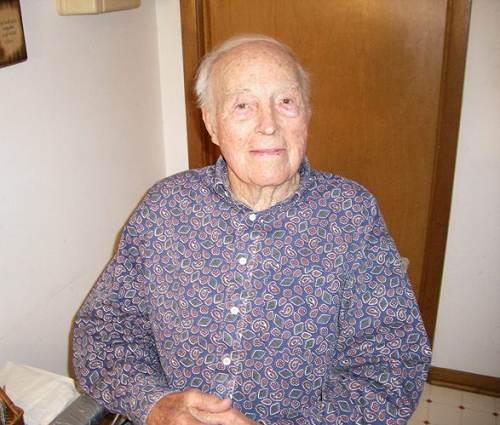
01 Royal Kallenbach
Royal had volunteered much of his time years ago working to transform the old
Anchor Mill Hardware store in Tuscumbia into a museum building during the time immediately
after it was purchased by the Historical Society in 1989. Although at the time he was a
very busy farmer he is the one who built the porch rails and support posts, built the
rooms inside the building, and participated in the plumbing and electrical revisions and
additions.
One of the toughest jobs he had was removing the years of collected stains from walnuts
and other produce and products which were stored on the basement floor over many years.
Royal says that this was an "on hands and knees" job as he had to use a hammer
and chisel for much the removal over the almost three thousand square foot floor. But
without his efforts, the area never would have been acceptable as a place for the meals
and meetings held by the Miller County Historical Society over the years.
I took Royal on a personal guided tour to show him how we have incorporated the
museum's artifacts and historical items into displays organized by theme and subject
capitalizing on the increased square footage to give a feeling of spaciousness. Royal was
pleased by the lighting which made it easy to read the very helpful descriptions of each
display item printed on placards attached to the walls. But in turn Royal gave me an
historical tour of the old building pointing out which sections were used for various
functions when it was a hardware store and also pointing out the many changes he and
others had made to the building after its purchase.
One major change was to remove the old wood burning furnace and replace it with a gas
operated one upstairs as well as putting in new gas heaters in the basement. Another was
the installation of bathrooms and construction of a sewage removal system and lagoon.
Royal recalled that the present kitchen electric range we still use he purchased for one
hundred dollars. The very strongly constructed folding chairs we still use for events were
purchased through a deal made by Royal with Wal-Mart of Eldon getting seventy five of them
for seven dollars each. Royal built the south stairs leading up from the basement to the
main level.
During the middle of our tour I showed Royal the east wall of the new upper level where
we have placed the portraits of famous Miller County citizens of the past. It was then
that Royal noticed something that was unbelievably coincidental: juxtaposed on the wall
were two portraits which were old photographs of Royal's very own grandparents; that is to
say, one portrait was of his grandparents on his father's side (Johann Valentine
Kallenbach and his wife) (photo 02),
and the other portrait was of his grandparents on his mother's side (Greene Lee Tomson and
his wife) (photo 03).
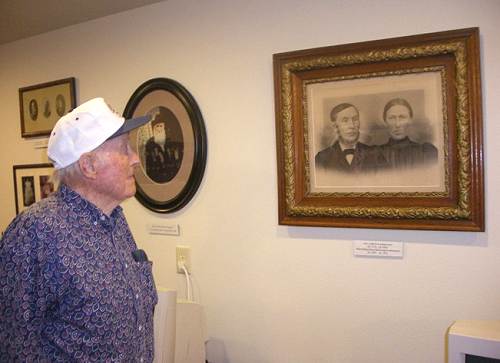
02 Royal and Photo of Johann and Maria
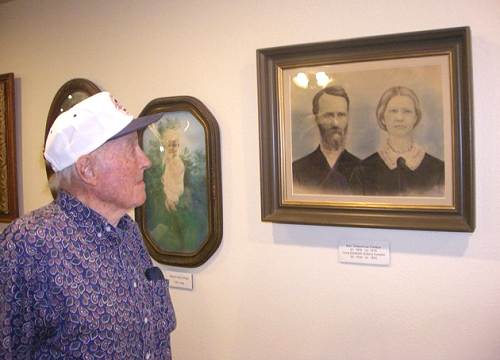
03 Royal and Photo of Green Lee and Cora Thomson
Royal's Kallenbach family history is one of the more interesting ones of Miller
County, for one reason because the first two generations had large families leaving a
large number of descendents many of whom have moved to other areas of the state and
nation. However, the Kallenbach family has a yearly reunion which is quite well attended
and organized. We are very proud that the family has chosen our museum for its 2009
reunion.
As an example of the size of the early Kallenbach families in Miller County we can
simply look at Royal's own family. Here is a family photo taken quite a few years ago on
the event of the sixtieth wedding anniversary of Will Kallenbach, Royal's father (photo 04). The photo shows the sons and
daughters of William and Cora Belle Kallenbach in September 1948.
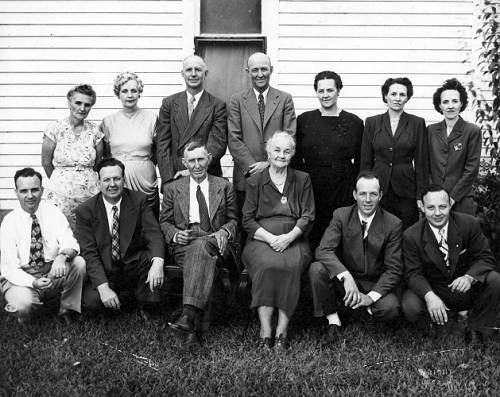
04 Kallenbach Family Reunion - 1948
It was taken in front of the home of William and Cora who are seated in the
center. Front row, left to right; Dr. Parnell Kallenbach, Robert Kallenbach, William
Kallenbach (father), Cora Belle Thomson (mother) Royal, Forrest Jean. Back row, left to
right; Gola, Ethyl Mauzy, Harry Kallenbach, Val Kallenbach, Cora Elizabeth Wolverton, Dean
Gregory, Kathyleen Blankenship. One of Royal's brothers pictured in the family photo,
Parnell, was one of the first Tuscumbia High School graduates to go to medical school and
become a physician. Of course, considering that Parnell is now 95, that was quite a few
years ago. Parnell practiced for more than fifty years in Mexico, Mo. and delivered more
than five thousand babies. He wrote his autobiography, a copy of which we have in our
library, which is very interesting and informative, especially about his early years
growing up. Here is another really interesting photo of Royal's family taken in 1909
before he was born in 1916 (photo 05).
The photo beautifully has been retouched with color and was taken from a Kallenbach
website which I will list below a little later in the narrative.
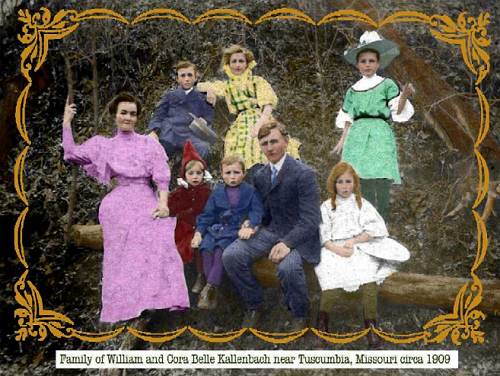
05 Family of William and Cora Belle Kallenbach near Tuscumbia - 1909
Another Kallenbach who wrote his own autobiography was Joseph, son of John
Edward, and grandson of Johann Valentine Kallenbach (photo 06). Joseph, raised in Tuscumbia, earned a PhD in
Political Science and taught at the University of Michigan for many years. His
autobiography is in our library also and had been invaluable as a resource of what life
was like in Tuscumbia at the beginning of the last century. Joseph was a nephew of Royal's
father, Will.
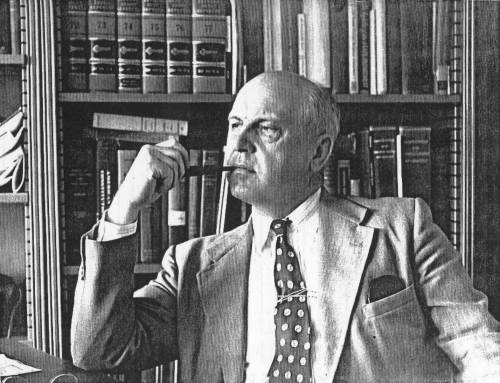
06 Joseph Kallenbach, PhD Univ. Michigan
Royal is the Kallenbach who donated to our museum a very rare Austrian made
shotgun owned by his grandfather, Johann Valentine Kallenbach. The gun was crafted by
Austrian gunsmiths in Klagenfurt, Austria in the early 1800's (photo 07). Johann had requested that the gun always be handed
down to a Kallenbach descendent who had Valentine as part of his name. After Royal's
brother, Frederick Valentine passed away, no other Valentine Kallenbach was living so
Royal took possession of the shotgun.

07 Austrian Double Barrel Shotgun
As noted above, the Miller County Kallenbach family is an extended one which by
now, more than a century and a half since Johann Valentin arrived, has many members who
have moved to various places all across our country. Many of the early Kallenbachs'
contributed significantly to Miller County history.
Pictured here is the Kallenbach family crest (photo
10):
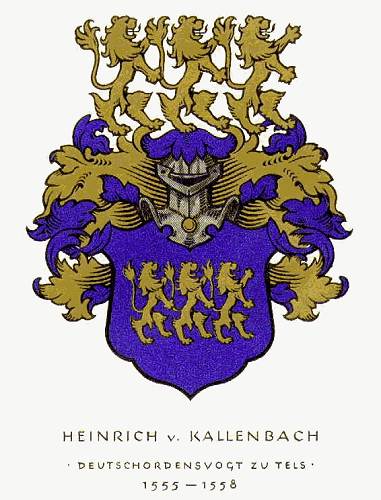
10 Kallenbach Crest
Here is a section from Don Blankenship's website about Johann Valentin Kallenbach:
Generation
No. 6
35. Johann Valentine6
Kallenbach (Johannes5, Hartmann4, Conrad3,
Just2, Claus1) was born 08 March 1816 in Liembach, Germany, and died
28 September 1899 in Tuscumbia, (Miller County) Missouri.
He married (1) Anna
Catharina Scharfenberg 19 April 1842 in Salzungen, Germany, daughter of
Johann Scharfenberg and Anna Urban. She was born Abt. 1817 in prob. Liembach, Germany, and
died 25 May 1856 in Liembach, (State of Thuringia) Germany.
He married (2) Maria
Magdalene Recknagel 08 June 1858 in Langenfeld, Germany, daughter of
Jacobus Recknagel and Susanne Necke. She was born 14 May 1837 in Langerfeld, Germany, and
died 23 September 1875 in Tuscumbia, (Miller County) Missouri.
Notes for Johann Valentine Kallenbach:
Birth records for JOHANN VALENTIN KALLENBACH are from
Lutheran Church documents found in Bad Salzungen, Germany by Herr Werner Schneyer,
Superintendent of Archives. Mary Louise (Curtiss) Roberts was responsible for performing
genealogy research during the early 1980's which initially uncovered the Kallenbach family
roots in central Germany. The spelling Kallenbach is in high German as recorded at the
time the birth documents was originated.
It is JOHANN VALENTIN KALLENBACH whom we more readily
identify as Valentine Kallenbach, the emigrant ancestor who bequeathed us a worthwhile
heritage of a love of the land, and a work ethic that the "good life" can only
be secured by diligence and a caring for others. His children learned to be resourceful
and reverent. They were sturdy and practical, honest and patriotic. It was Valentine whose
personal life begins the factual recording of the Kallenbach lineage and history in
America.
Up until the early 1980's it was uncertain where
Valentine actually came from in Germany. Some recall Valentine saying he came from an area
which he pronounced as "Socks-Mining", Germany. Research done by his great great
granddaughter, Mary Lou (Curtis) Roberts, unraveled the mystery when she discovered in
very old travel books that Socks-Mining was actually Saxe-Meiningen, or the township of
Meiningen in the State of Saxony in central Germany. Mary Lou further confirmed this
deduction when she discovered an early 1900's postcard sent from relatives in Germany to
Valentine's second wife Maria Magdolena which was postmarked Salzungen, Germany, located
just a few kilometers from Meiningen, Germany.
Johann Valentine Kallenbach spelled his name Valtin
Kalbach on documents he signed in America. Lutheran church records in Germany document his
birth in 1816 and reflect the German spelling of his name as Valten Kallenbach. Valten
Kallenbach or, to use the Anglicized spelling, Valentine Kallenbach, was a fairly common
name in the State of Saxony, Germany during the era in which he was born. Mormon
genealogical records show several people by that same name as living in the area of
Meiningen, Germany during the 1600's and 1700's. Again, it was Mary Lou Roberts, who in
the early 1980's, discovered Johann Valentin Kallenbach's German roots by her arduous
genealogical research methods and with the help of a church superintendent in Salzungen,
in what was then communist East Germany.
Extracts from the birth register of the Evangelical
Lutheran church in Salzungen, Germany for the year 1816 (Page 601 of book 43) reveal that
Valentin Kallenbach was the 5th son of five children and that he was born 9 March 1816 in
the village of Leimbach, located in central Germany. He was christened on 16 March 1816 in
Salzungen, Germany. It is assumed that Salzungen was the birthplace of his mother in
accordance with the custom of the day wherein children were christened in the mother's
church. His Godfather was Leyherr ((1 word illegible)) Johann Valentin, mayor, miller and
farmer of lmmelborn, Germany. From other old church records of the time Valentine is
reported to have been a master weaver. Presumably he had successfully passed through the
various levels of proficiency of the Weavers Guild to become a master weaver.
Valentine married his first wife, Anna Christina
Scharfenberg, at the age of 26 on 19 April 1842 in Salzungen, Germany. She is said to have
come from a rather well-to-do family that was possibly engaged in the manufacture of linen
or woolen cloth. However, church records indicate that Anna's father was a farmer with no
mention of his being engaged in weaving. Anna was the second daughter of Johannes
Scharfenberg and his wife Anna Christina Urban.
Sometime around 1855 Valentine and his brother George
decided to travel to America via Canada. The two brothers from Leimbach, raised in the
state of Saxony, Germany were eager to travel abroad to America. We do not know why they
chose to enter Canada first. However, Professor Joseph Ernest Kallenbach believed the
reason was due to growing dissension among the Prussian states of that era and the
possibility that immigration agreements between the U.S. and the German Confederation of
States had not been properly implemented. Therefore, there may have been U.S. immigration
restrictions for certain Germanic people entering America during the mid-1800's. It may
have been possible that by entering Canada first and establishing temporary residency
there, it later would be easier for them to enter the U.S. In coming to America Valentine
may have been looking for a possible escape for his three young sons to avoid their being
drafted into service for the Prussian army. Uprisings began in the German States in 1848
in an attempt to end the vestiges of feudalism that existed there at that time and also to
bring about greater democracy. There was a desire to unify these German States under a
stronger central government. Political and military conflict among German people during
the 1850's seemed inevitable.
After arriving in Canada George and Valentine may
have sometime later slipped into the United States. John Edward Kallenbach, the second
child of Valentine by his second wife Maria Magdolena, recalled for his son Joseph Ernest
that Valentine and George first traveled to Western Ontario, Canada just across the U.S.
Canadian border. They apparently stayed there for a while. It was never clear that George
and Valentine did, in fact, enter the U.S. during Valentine's first trip to North America.
Valentine, then 40, probably returned to Germany sometime around 1856 and found that his
first wife Anna, whom he married at the age of 19, had suddenly died from smallpox while
he was traveling in North America. It is believed that his brother George remained in
North America after Valentine returned to Germany. Rumors were that George may have died
at the hands of American Indians but there are no facts to support the story and there is
no historical basis for Indian uprisings at that time in the areas they are likely to have
visited.
Valentine married for the second time at age 42 on 8
June 1858 in Langenfeld, Germany to Maria Magdalena Recknagel, the only daughter of master
tailor Jacobus Recknagel and his wife Susanne Necke of Langenfeld. Valentine was a man of
medium height, sturdily built with reddish-brown hair and rather deep-set brown eyes. He
was a man of robust strength and evidently very enterprising and a hard worker. He liked
to hunt and fish. His wife Maria was described as a stronger than average woman, somewhat
taller than Valentine. She had brown hair and blue eyes. Accounts agree that she was a
good mother both to her three stepsons and to the seven children she had with Valentine.
It is said that Valentine's inheritance from his
first wife Anna's estate later paid for travel expenses for Valentine's sons Henry, John
and George and his beautiful second wife Maria (Mary) Magdolena Rechnagel to emigrate to
the United States. The money also paid for the Kallenbach family farm Valentine later
purchased some three miles north northwest of Tuscumbia, Missouri. It is known that
Valentine paid for the 365 acre farm with $550 in gold he brought from Germany. Aaron and
Elizabeth Roberts sold him the farm on 14 July 1860 and the deed was officially recorded
on 20 July 1860. Twelve years later on 18 May 1872 Valentine entered into a lease
agreement for mineral rights on the property he had earlier purchased. The lease allowed
him and two of his sons, John and George, to also mine the property. Among the minerals on
his land were coal, silver, lead, copper, kaolin and iron. He was to be paid one cent per
bushel of coal, one twentieth of a cent per bushel for silver and ten cents per ton for
iron. However, there is no information available to suggest the farm site in Miller County
was ever mined for any of these minerals. It also may be noted that the total population
of Miller County in 1850 was recorded by the U.S. Census Bureau as 772 people. About half
this number lived in the County Seat of Tuscumbia along the Osage River, which then was a
major transshipment point with connections to other waterways.
The property Valentine purchased had a small log
cabin which was expanded in size sometime after he purchased it in mid-summer of 1860. The
exact location of the log cabin, some three miles north northwest of Tuscumbia, Mo. was
latitude 38 degrees, 16 minutes 38 seconds North and longitude 92 degrees, 28 minutes, 22
seconds West. The farm site remained in Valentine's name until 1897 when he sold it to
William Kallenbach (Royal's father), a son by his second wife
Maria Magdolena Rechnagel. The log cabin was torn down around 1900 when William Kallenbach
replaced it with a more modern two story structure that later burned to the ground in
about 1913. The farm site offered about 20 to 30 acres of good bottom land for growing
crops along the Little Saline creek. On these productive acres he raised corn, wheat oats
and hay. There also was abundant land for vegetable gardens and orchards. There were woods
on most of the hilly land surrounding his crop lands and this provided fuel. Many old
walnut trees still abound there today. On the farm were deer, wild turkeys, rabbits, quail
and squirrels which augmented the crops they raised.
When Valentine and his family traveled to America his
second wife Maria was only 21 and he was 42. They were married in 1858 some two years
after Valentine's first wife died. It appears that while Valentine and his brother George
were in America, Maria apparently had cared for his three sons by his first wife Anna
following her death. Maria Magdolena reportedly was a cousin of his first wife Anna.
Valentine's three sons Henry, John and George who came with him to America in 1860 were at
the time 17, 14 and 9 years old, respectively.
Early maps of Valentine's birth place clearly show
the locations of the linen, wool and silk manufacturing industries in Saxony, Germany
where he grew up. Unfortunately the organization of factory union groups after the
industrial revolution coupled with the famine of the mid 1800's created much rioting and
many union members were jailed or banished in that part of Germany. Also, the political
unrest and the ever growing menace of the Prussian army may have motivated him to come to
America with his brother George during the 1850's. We can easily assume that he was
anxious to emigrate to America, the place he had been hearing about for so long. The
beauty and the opportunity to settle in Missouri had been well publicized by a German
friend who had come to Missouri from Coburg, southeast of Meiningen. This man returned
with glowing reports about the bountiful land and the great opportunities. Chances are
that Valentine had a definite idea of where he wanted to settle when he returned to
America in 1860.
During Valentine's second trip to North America with
his three German born sons and his second wife Maria, they traveled on the sailing vessel
Louisiana which arrived in New York harbor on May 17, 1860. The ship's master was D.
Mueller and it departed from Bremen, Germany. Sometime after departure the sailing ship
was be-calmed at sea and the subsequent delay required mandatory rationing of food and
water. During the Atlantic crossing it was reported that his son John Valentine became
quite ill and they thought he might die. His illness was only an intestinal disorder,
possibly caused by the food or water. The ship's passenger manifest, now located in the
National Archives in Washington DC, stated that Valentine and his family intended to make
their final destination Cleveland, Ohio. Cleveland was then a large center for German
immigrants and Valentine may have intended to search for his lost brother George whom he
left in America three or four years earlier. We don't actually know if he went to
Cleveland first before stopping in St. Louis and later Osage City or Jefferson City,
Missouri. We do know, however, that the 1880 census for Ohio shows a certain George
Kallenbach was living in the township of Salem in Ottawa County, not far from Cleveland.
Unfortunately no relationship can be inferred nor can we assume that this particular
George Kallenbach was related to Valentine.
A search of available U.S. census records at the time
of Valentine's arrival in 1860 indicates that only one Kallenbach was recorded in the 1860
census and that person was Henry Kallenbach living in New York. Ten years later in 1870
the available U.S. census records show a Jacob Kallenbach living in California, a
Christine Kallenbach living in St. Louis and an Andrew Kallenbach living in Illinois.
Census records for the U.S. during the mid-1800's are undoubtedly incomplete or missing
but by 1880 there still were fewer than 20 Kallenbach's noted on these U.S. census
records.
One of Johann Valentine Kallenbach's old family
trunks was stamped with the word Frankfurt. From this it is assumed that he and his family
traveled from his home town in or near Leimbach, Germany northward to Frankfurt and then
further north to the port of Bremen, Germany where his family sailed for New York City. A
railway map of Germany for that era shows a rail line traversing this route.
Unfortunately, all German passenger documents regarding the ship Louisiana and its May
1860 passage to America were lost during allied bombing raids in World War II.
Why Valentine Kallenbach and his family chose
Tuscumbia, Missouri as their final destination in America is unknown. The town is located
on the north bank of the Osage River. It is almost in the geographical center of both
Miller County and the state of Missouri. The land which Tuscumbia sits on was designated
the county seat even before an actual town was established there. The first real evidence
of western civilization in Tuscumbia was a small log cabin nearby the "Shut-in"
branch (or stream) which flows into the Osage. This apparently was the location of a
trading post for dealing with the local Indians. The log cabin was constructed during the
1820's by the Dixon family who gave Tuscumbia its name. They arrived at this spot on the
Osage River from a village in northern Alabama called Tuscumbia which had been named after
an Indian chief whom the Dixon's admired. Indian chief Tuscumbia then lived along the
Tennessee River in northern Alabama. The Dixon's decided to name their new Indian trading
post in Missouri by the same name as the Indian chief they so admired in Alabama. Some
fifteen to twenty years later the Dixon family no longer owned the trading post at
Tuscumbia, Missouri because by 1837 all of the surrounding land had been acquired by a man
named Harrison who had emigrated there from Virginia. Harrison offered some of his land
around Tuscumbia to Miller County if they would establish it as the new County seat of
government. The offer was accepted.
In addition to Tuscumbia becoming the County seat, it
also became a thriving way station along the Osage River. A great deal of steamboat
traffic arrived and departed there and a considerable number of these boats plied the
Osage River from around the time of the Civil War up until 1900. The names of the
steamboats of this long ago era owned by well to do people of Tuscumbia were the
"Fredrick", "Alice Gray", "Hugo", J.R. Wells",
"Ruth", and the "Homer C. Wright." A couple of steamboats were
actually built in Tuscumbia. The "Ruth", for instance, was built by Dan Tomson
(also Thompson), whose sister Cora Belle Tomson (also Thompson), later married Valentine's
son William Kallenbach. The Hauenstein's and Marshall's were the principal owners of many
of these steamboats which hauled freight and people up and down the Osage River.
Valentine apparently spoke only German when he
arrived in America but his wife Mary Magdolena could seemingly converse, and perhaps write
in broken English. In his later years, after living in America for some time, he did learn
to converse in English. However, in their log cabin home near Tuscumbia we know that only
German was spoken among Valentine and his immediate family. John Edward Kallenbach, son of
Valentine, related to Joseph Ernest Kallenbach (1903-1991) the fact that German was always
spoken between Valentine and his family members at home. Some six years after Valentine
purchased his farm he was required to appear at a trial in Tuscumbia on 28 August, 1866.
We know that during the trial Valentine required the use of a translator to address the
court. This was a trial against a man who had threatened to use a gun to kill Valentine
and one of his cows. The man who made the threat was a farm hand hired by Valentine to
work for him. With the help of William H. Hauenstein as the court's translator, Valentine
Kallenbach handily won the case. The man who made the threats, Abraham J. Hoagland, was
required to pay the court a $100 bond for his breach of the peace.
Valentine built a loom, and being skilled as a weaver
of fine cloth, he wove coverlets and Linsey-Woolsey cloth for his growing family and his
neighbors. He also farmed the land. Seven children were born to Valentine and Mary
Magdolena. The last two were twin boys named Charles Melton and John Milton, born 7
January 1875. Sadly, Charles Melton died at the age of three months. Valentine made a
little wooden coffin for the dead infant and he was buried in a serene spot under the
trees, not far from the log cabin. Stories were often told by Cora Belle Tomson, who with
her husband William Kallenbach, owned the old Kallenbach farm site for 61 years, that on
the exact site where baby Charles Melton was buried there sometimes appeared a soft
blue-white light. Her grandchildren often would gaze at the hillside burial site in awe
and anticipation they too might witness such an event.
Five months after baby Charles Melton died, the young
auburn haired mother, Maria Magdolena, died quite unexpectedly at the relatively young age
of 38. She died on 3 September 1875 of an abdominal ailment leaving seven young children
motherless. Her ailment presumably was appendicitis. When she died her youngest son John
Milton was only eight months old; Emma Augusta was three; William (who later married Cora
Belle Tomson) was five and a half; Mary was nine; and Louise Kallenbach was 14. A story is
handed down that on the warm September day of Maria's death, Valentine was outside the
house chopping wood. The sky was clear blue with no clouds. Quite suddenly, a single, very
mysterious stroke of lightning bolted across the sky. This startling event has never been
explained. Valentine continued to live at home for the next 24 years. He and his children
did the best they could to manage as a family following the death of their mother Maria.
Stories are told of Valentine continuing to care for the surviving infant John Milton. He
often would get up at night to fetch warm cow's milk when his baby son cried. It was not
an easy task for this man, then approaching 60 years of age, to carry this heavy burden of
responsibility.
Valentine began fathering children with his second
wife Maria when he was 45. His last children, twin boys John Milton and Charles Melton,
were born when he was just two month shy of his 59th birthday. Within the
Kallenbach--Thompson family tree, it is Valentine Kallenbach who holds the record for
fathering children at the oldest age. Only Valentine's son, Henry Kallenbach (by his first
wife Anna,) and Green Lee Tomson (the father of Cora Belle) even come close to Valentine's
record. Both Henry Kallenbach and Green Lee Tomson fathered their last children when they
were 55 years old.
Two years before Valentine's death in 1897 he sold
his farm to his son William Kallenbach, who five years earlier had married Cora Belle
Tomson. William and Cora were then living in Valentine's log cabin. It is said that
Valentine suffered greatly from arthritis pain during his final years. He was 83 years old
at the time of his death. Johann Valentine Kallenbach was buried next to his second wife
Mary Magdolena in the Tuscumbia cemetery in September 1899. His son William and wife Cora
Belle also were buried in the same cemetery near William's emigrant parents.
A description of Valentine Kallenbach and his home
and farm near Tuscumbia, Missouri was prepared in 1968 by Clara Mae (Kallenbach) Huegerich
(1879-1972). Clara Mae was the daughter of Valentine's son George Kallenbach (1851-1889)
who married Mary Ann Jeruwsha (Wright) Kallenbach. George was the youngest son of
Valentine by his first wife Anna Scharfenberg. When Clara Mae's mother Mary Ann and father
George died suddenly in January 1889, she went to live as a foster child in the home of
Valentine. She was a young girl of 10 at the time and Valentine was then 73.
The following paragraphs in quotes are Clara Mae's
own words written when she was 89 years old. They record her remembrances of Valentine
Kallenbach and his farm near Tuscumbia, Missouri:
"It was a large creek valley farm along a
large creek -- the little Saline on one side and a wooded hill on the other with plenty of
fields to raise all we needed and sell some, for what they raised and sold is all the way
they had of getting money."
"In the fields were raised corn and wheat and
a good garden; and meadows for hay and to let the cattle graze some. All, farm products
were gathered in when ripe except the young corn. Some of that was gotten in to eat by the
family when very young and tender. And there were some fruit trees scattered over the
farm, but there was a regular orchard on the hill. Fruit was mostly apples and peaches
that also had to be canned for winter use. In the woods were wild cherries, plums and
mulberry trees, black haws and red hews. And on small bushes were huckleberries, some
strawberries and lots of blackberries to make pies and be canned for winter use."
"The men folks raised horses, cattle, pigs and
sheep -- also many chickens and geese -- no ducks. The feathers from the geese were used
to make warm feather beds for us to sleep between in winter. And the wool cut from the
sheep's back was washed and taken to a carding mill which was run by the power of water
from a very large spring. The wool, cut from the sheep's backs was washed and taken to the
Wright's carding mill which was run by the power of water from a very large spring. It
then was turned into long rolls and prepared for grandpa's use on his big loom he brought
from Germany for he was a weaver as well as a farmer. Clara Mae remembered wearing dresses
Valentine wove, and he made blankets so nice and warm, and heavy blue cloth to make men's
pants."
"There were rabbits, squirrels and quail, all
of which were good to eat. The o'possums and raccoons were not good to eat. There were
lots of snakes in those days -- copperheads, rattlesnakes and big black snakes that would
swallow hen eggs and small chicks if they found them."
"Grandpa's (Valentine K.) house was a large
log cabin with a summer kitchen where I would wash dishes and sing as I washed. And when
the time came that we two orphans must go to school, we had to walk about one and a half
miles through all kinds of bad weather to the little (Wright) school house. But it was a
good life."
A story told by Valentine's son John Edward is that a
severe drought affected central Missouri during the 1870's and caused tremendous hardship
on the Kallenbach family. Accompanying the drought was an infestation of grasshoppers or
locusts. As a consequence the crops failed and the family's food supply during the
following winter was seriously affected. The family had been entirely dependent upon what
they raised for food. By the end of the following winter their food supply was entirely
exhausted such that the only food they had to live on was corn bread, parched corn and sow
belly from a semi-wild hog Valentine had managed to stalk and kill in the woods.
During Valentine's final years he became somewhat
crippled with arthritis, and it is said he was confined to a wheel-chair, partly because
of having been butted by a goat. During that time he was cared for by his son William who
was then married to Cora Belle Tomson. Valentine died on September 1899. His burial place
is alongside that of his wife Maria and is marked by a stone in the Tuscumbia, Mo.
cemetery.
Many stories were told of the strength and
determination of Valentine the man. Once when returning home after paying his taxes he
came upon a group of men butchering hogs. The location of the site was several miles
distance from his home near Tuscumbia. He purchased one of the butchered hogs by bartering
his beautifully embossed gun powder pouch used for his muzzle-loader gun which he carried
for protection. Both the gun and the pouch were made in Germany. After making the trade he
then proceeded to carry the pig carcass, weighing over 100 pounds, to his home some 15
miles away. He simply hoisted it on his back and trudged the distance (Note:
the gun, photo 07 above,
now is on display in our museum).
Wilma (Page) Kallenbach (1907-1978) was the first
wife of Harry Kallenbach, a grandson of Valentine Kallenbach. She did much early research
and genealogy on the Kallenbach family and related many stories of the legendary strength
of Valentine Kallenbach in his middle years. Valentine, she recalls from accounts, was
able to lift and carry a whole hog great distances, or to hoist a log or clear a field --
yet he was tender and kind to the orphaned infants he cared for. Angered by the Prussian
militants, Valentine was capable of patriotism for the Union cause in the Civil War. He
taught his children to love the soil and to cherish his adopted country. His children
adapted so readily to life in central Missouri that he apparently never looked back to his
European roots.
After talking with Royal and learning about his family history I thought it would be
interesting to take a tour with him of the Little Saline Creek valley and let him point
out to me who was living where a hundred and more years ago. After admiring his large
garden (photo 11) we left his house in
Eldon and traveled south on route M turning right after a short distance onto a recently
black topped road which passes through some of the prettiest scenery in Miller County.
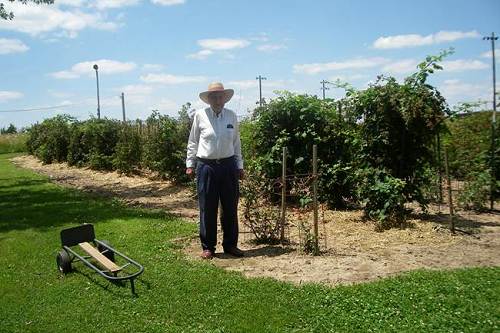
11 Royal's Garden
This area is made up of hills and valleys which have rapidly flowing creeks with
flat rock bottoms fed by numerous small springs hidden by ferns and large trees (photo 12). One large sycamore along the
road Royal rememberd as the same one he walked by when he was a boy (photo 13).
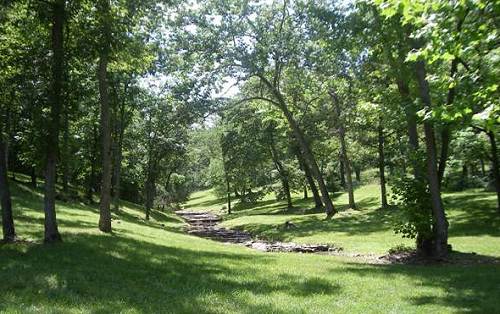
12 Spring Fed Creek

13 Old Sycamore Tree
Soon we came to a large white house which was built in 1903 by Royal's uncle, Dan
Thompson, the carpenter. I discussed Dan in this space several weeks ago (5 12 2008). Presently, Mr. and Mrs. Chet Zuck live
here have bought the property several years ago. They have spent much time and effort
restoring it to its original beauty (photo 14).
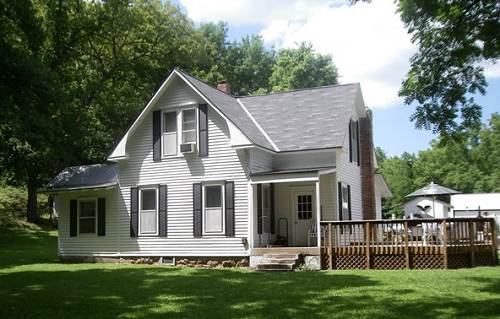
14 Dan Thompson - Zuck Home
The Chickpea tree in the yard is the same one as when Royal was a boy except it
is larger (photo 15). Royal remembered
black snakes would crawl up the tree trunk to catch insects to eat, sometimes hanging off
a branch wagging their heads from one side to another surveying the other branches of the
tree.

15 Old Chickpea Tree
Mrs. Zuck met us in the yard and showed us around pointing out the many areas of
landscaping they have laboriously placed around the property.
Then we and the Zucks' traveled on down the Little Saline Creek road to go to the
original Kallenbach property which was where Johann Valentin built his first home and
where the Zuck's son, Clint and his family, live. On the way we passed by a rather large
hill. Royal said this hill was called, simply enough, "High Hill (photo 16)."
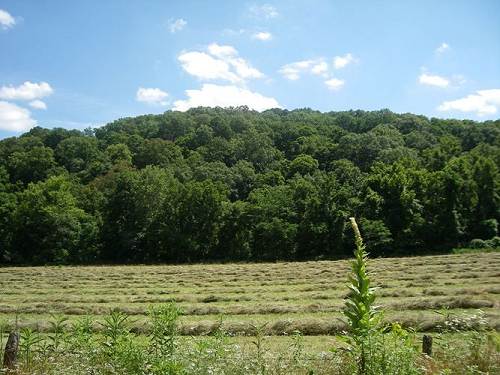
16 High Hill
Royal said that in the winter time when the leaves were off the trees you could
see in the distance five different towns in Miller County. Once he cut thirty thousand
feet of logs off this hill and with a team of horses brought them down to the valley
below.
Then we reached the Kallenbach home place. One can appreciate how new and fresh it
looks after the renovation by Mr. and Mrs. Zuck and son, Clint (photo 17).
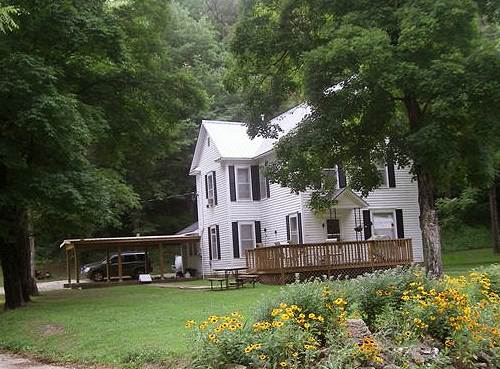
17 Kallenbach Original Home Place
The website by Don Blankenship copied above has a photo of this same house nearly
one hundred years ago (photo 18).
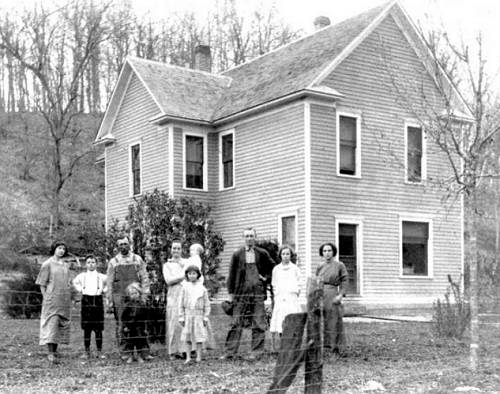
18 Old Kallenbach Home - 1913
Here is a photo of a framed picture of the house taken in the fall of the year
quite a few years ago (photo 19).
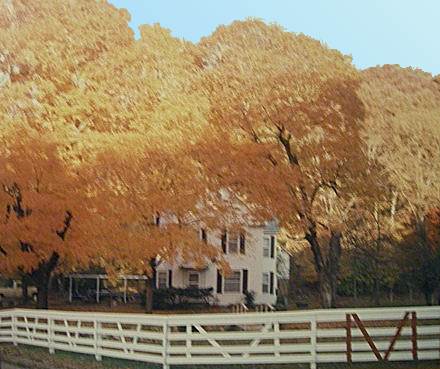
19 Kallenbach Home in the Fall
Royal confirms the story told above from the Blankenship website that the
original home was a log house. A second house was destroyed by fire in 1913. The family
had to live in a smoke house (photo 20)
until the third one was built, the one pictured in the previous three photos. The new
house was built by Royal's uncle Dan Thompson and this is the house which is standing
today and which has been so beautifully renovated by the Zuck family.
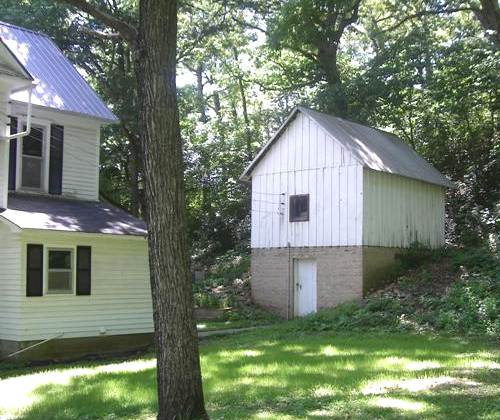
20 Original Smoke House
In the narrative above from the Blankenship website the story was told of the
young Kallenbach baby, Robert Melton, dying soon after birth. As noted in the story the
baby was buried just behind the house next to the hill under two cedar trees and marked by
a stone. Over the years the cedar trees have died and the stone has fallen and the
lettering has worn off. However, the Zucks sculptured a cross out of the trunk of the old
cedar tree as a remembrance of the baby who died so many years ago (photo 21).
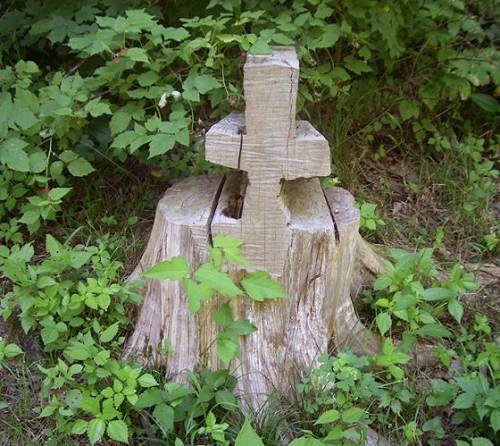
21 Burial Site of Robert Melton Kallenbach
Walking around the yard Royal pointed out the hog slaughtering tree, a large
walnut tree which had a strong long branch extending off the trunk where the slain hogs
were hung to bleed. In later years that branch has fallen off but the tree remains (photo 22).
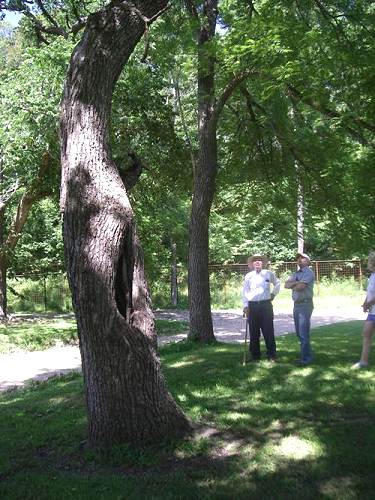
22 Hog Hanging Tree
The old barn remains and is in good repair thanks to some rehabilitation by the
Zucks' (photo 23). Inside one could
see the way the support beams were put together by Royal's uncle Dan Thompson (photo 24). Royal was able to remember the
names of the five horses stabled in the barn and which stable each had for its own.
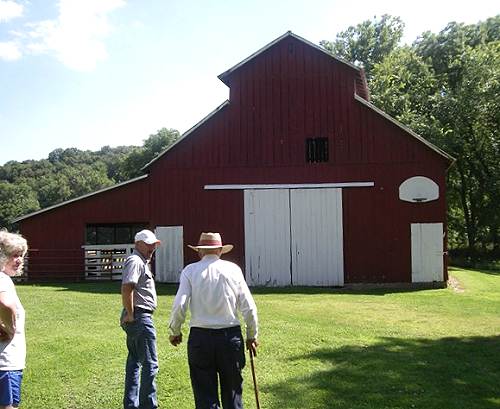
23 Original Barn
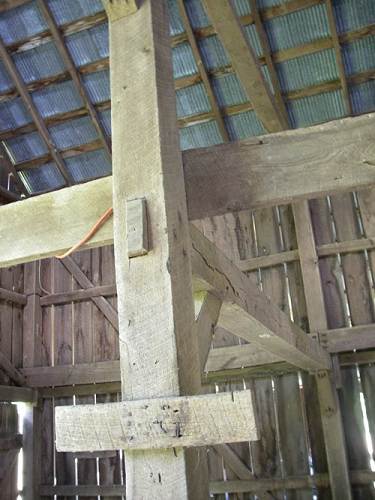
24 Support Beams
Inside the home Royal reminisced about happenings of long ago as he passed
through each room. Although the home was built by Royal's grandfather, Johann Valentine
Kallenbach, it was Royal's father, Will, who ended up with the farm and home after Johann
passed away purchasing it from the other heirs. So Royal and his brothers and sisters were
the ones to grow up in it and farm the surrounding creek bottom land.
The Zucks' added to the beauty of the home by asking the well known local Eldon artist,
Anita Rogers, to paint some scenes of the farm on a door in the drawing room (photo 25). Also featured in the drawing
room is a carving on the stair step post done by the builder of the house, Dan Thompson (photo 26).
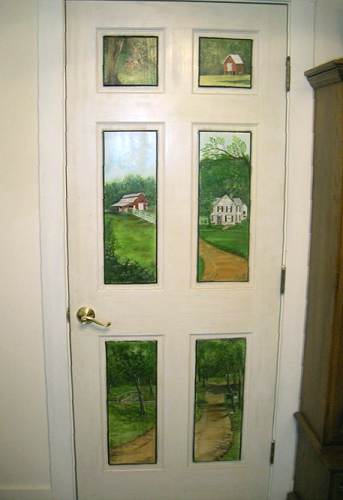
25 Paintings on Door
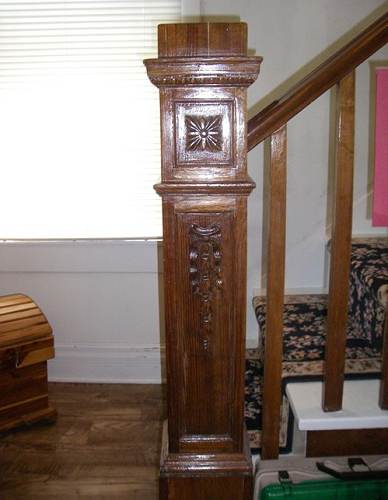
26 Carving on Post
After thanking the Zucks' for their hospitality Royal and I went on down the road
a ways to the Wright Spring. The spring comes up out of the creek valley in a dispersed
sort of way forming a large pond out of which the water emerges to form a fast running
creek which eventually empties into the Little Saline Creek. Here is a photo (photo 27) of the spring water where it has
been concentrated into a trough to lead to the creek away from the pond.
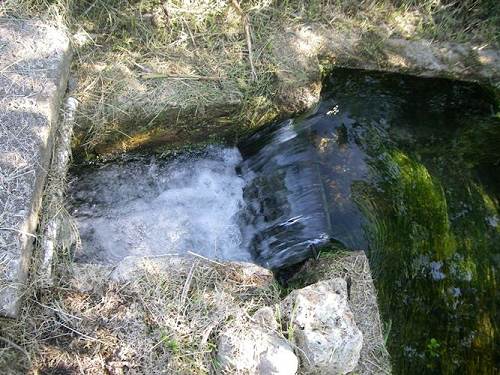
27 Wright Spring
At one time a small mill was operated here Royal says, but a little farther down
the creek is where the famous Wright Carding mill was located, built by James Lawrence
Wright when he owned the land. The mill no longer is standing but here is an old photo of
it (photo 28).
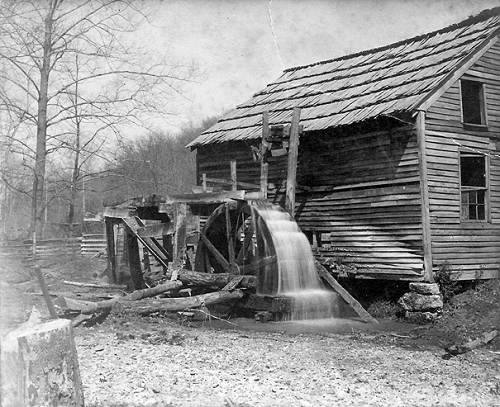
28 Wright Carding Mill at Wright Spring on the Little Saline Creek
For orientation to this area is a map taken from the Blankenship website which
displays the relative locations of the Dan Thompson home, the original Kallenbach
homeplace, and the Wright Spring (photo 29).
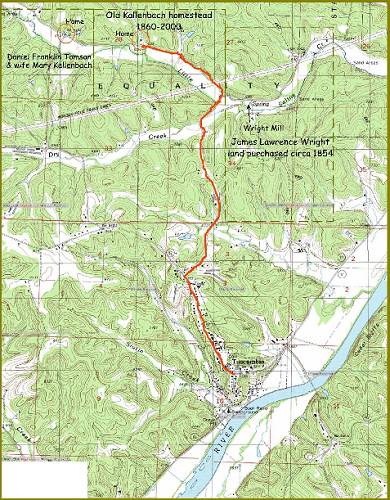
29 Map of Kallenbach - Thompson Homes and Wright Mill
Click image for larger view
Going on down the gravel road from the location of the Wright Spring we went by
the location where the Wright One Room school was located (photo 29a). It no longer is standing. The photo was from the
collection of Ruth Wells who is the one who wrote the caption. The Wells farm was located
just a mile or two to the south.
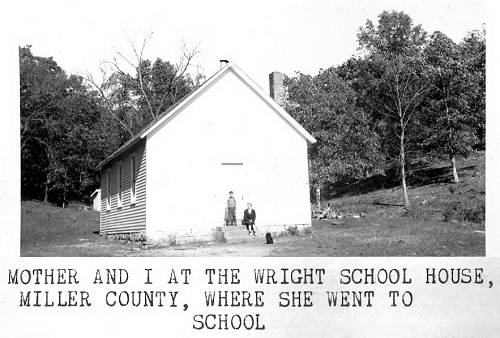
29a Wright School
Then we came upon the old Saline Valley Church of Christ where the Kallenbach and
Wright families went to church. It is still an active church (photo 29b). Here is a painting of the church by Francesca
Wright (photo 29c).
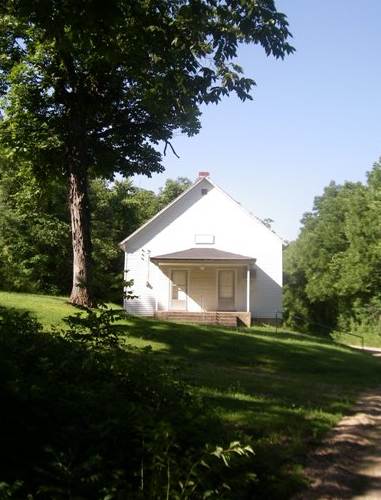
29b Saline Valley Church of Christ
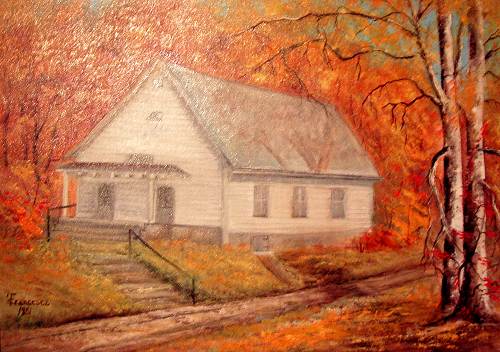
29c Saline Valley Church of Christ - Painted by Francesca Wright
Then we came upon the farm owned by John Kallenbach, son of Johann by his first
wife, and farms owned by John's sons, Edison and Fritz Kallenbach. John Kallenbach (photo 30) was the well known Tuscumbia
black smith and wagon maker.
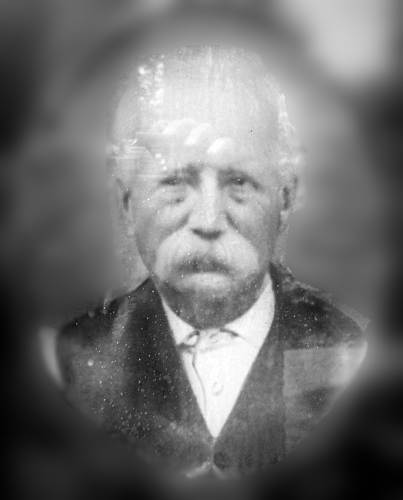
30 John Kallenbach
The photo just noted is in the possession of Brice Kallenbach of Eldon, one of
John's grandsons. John had a blacksmith shop in Tuscumbia across from the old Woodman Hall
building. One of his wagons now is owned by Brice, who has loaned it to our Miller County
Historical Society for parade events (photo 31).
I am sure it gave us the extra feature needed to enable us to win two blue ribbons last
year when we participated in community parades.
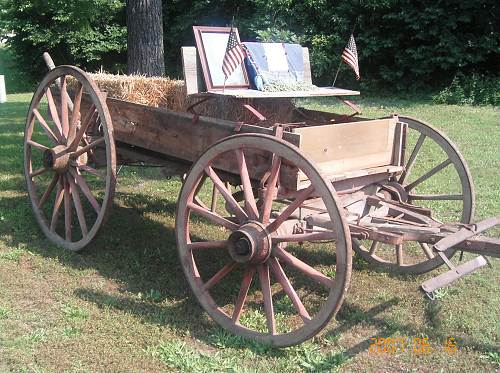
31 Kallenbach Wagon
Here is a photo of John Kallenbach along with his half brothers Will, Ed, and
Milton (photo 32). As noted above,
Will was Royal's father.
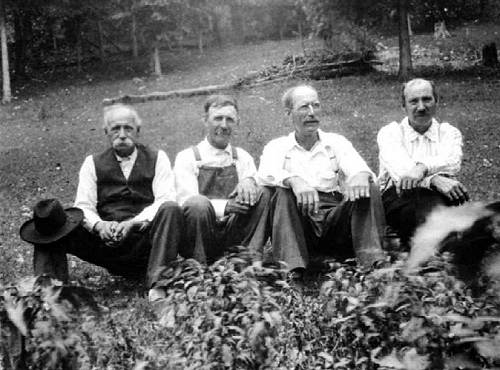
32 John, William, Ed and Milton Kallenbach
John was well known in the community for which reason he was elected to serve as
circuit clerk (photo 33).
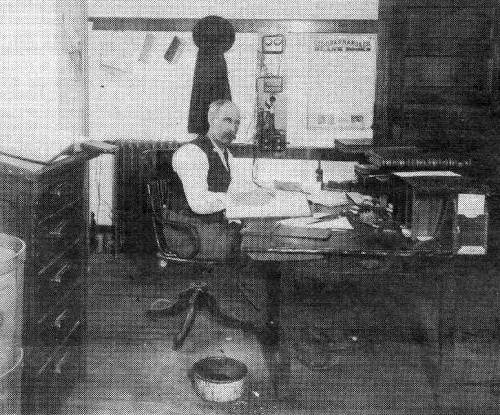
33 John Kallenbach - Circuit Clerk
Being mechanically adept, he had one of the first cars in town (photo 34).
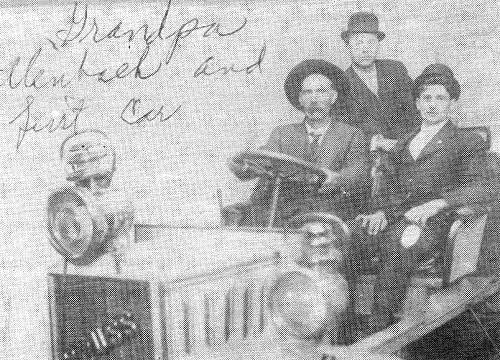
34 John Kallenbach with First Car
Ed Kallenbach, another son of Johann by his second wife, lived in Tuscumbia on
the east side in what is known as the Crackerneck area. He had a large home on the hill (photo 35) which is still standing and was
built by Dan Thompson. Ed had three sons well known in Tuscumbia. One son, Joseph
Kallenbach, is pictured in (photo 06 above)
and as noted there, became a professor of Political Science at the University of Michigan.
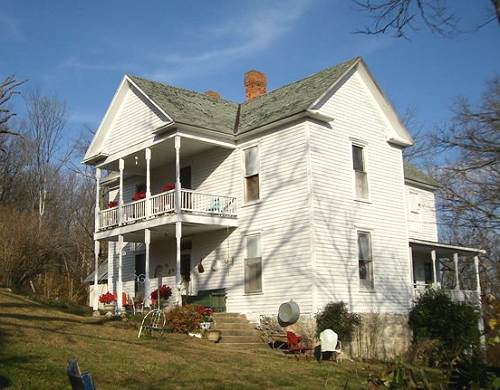
35 Ed Kallenbach Home
Dewey, another older son, stayed in Tuscumbia and was known as being a genius
mechanic and woodworker. Later he owned an appliance store. Here is a photo of Dewey and
Charles McDowell, the stone mason who built the old field stone hardware store for Anchor
Mill which now serves as our museum (photo 36)
In this photo of Dewey and Charles, improvements were being made to the Tuscumbia Cemetery
financed by a gift from Hollywood producer, Paul Henning, whose wife, and subsequently
himself, were buried there.
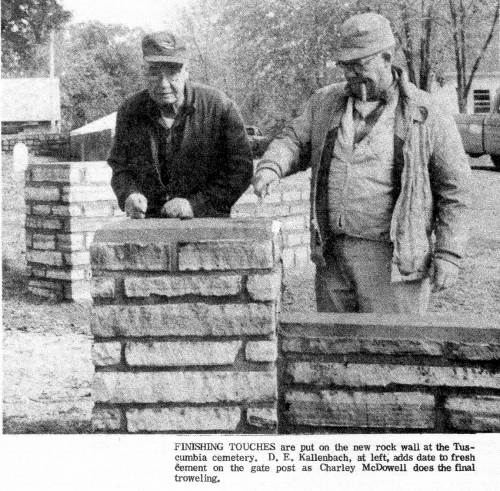
36 Dewey Kallenbach and Charles McDowell
Click image for larger view
Leonard Kallenbach ran a grocery store for many years near the courthouse. He
also was circuit clerk for awhile (photo 37).
Both Dewey and Leonard worked in the old Hauenstein's Store when Mrs. Ida Hauenstein owned
it.
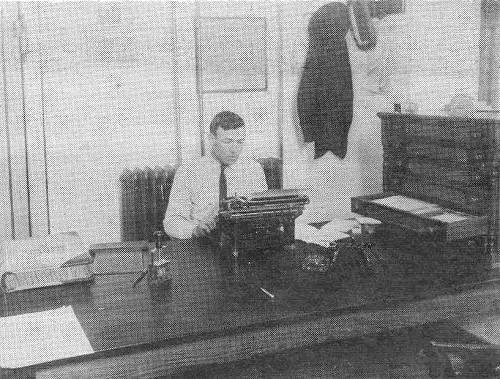
37 Leonard Kallenbach - Deputy Circuit Clerk - 1914
So this is Royal's family history. But this history is so much more interesting
if one has the opportunity to talk to Royal in person. His memory is excellent and he can
recount one old story after another as long as you want to listen. For my part, being born
and raised in the area, knowing several of Royal's kin folk, and having gone to school
with some of them, I never get bored.
Last week our country celebrated Independence Day once again. This day, commonly known
as the Fourth of July, is a federal holiday commemorating the adoption of the Declaration
of Independence on July 4, 1776, declaring independence from the Kingdom of Great Britain.
One of the symbols most demonstrated during this time of celebration is our national flag.
A few weeks ago I featured the collection of memorabilia owned by Al Kliethermes of Eldon
having to do with the Bicentennial of that event which was celebrated in our country
during 1976. One of the items of Al's display is a beautiful book containing photographs
of paintings by various artists having to do with the Declaration of Independence, one of
which depicts Betsy Ross sewing the first official flag of the United States.
Not so long ago I learned that a great great granddaughter of Betsy Ross was our
own Mrs. Carl T. Buehler of Eldon (photo 39).
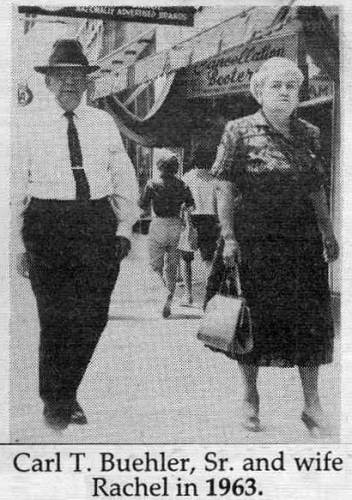
39 Mr. and Mrs. Carl T. Buehler Sr.
Carl had a pharmacy for many years in Eldon and his son, Carl Jr. was a medical
doctor in Eldon. So I thought it would be appropriate to reproduce here an article from
the Kansas City Star about Mrs. Buehler's famous grandmother:
Kansas City Star
July, 14, 1962
Betsy Ross Story
Some pages are missing from the early day history of
the United Sates flag. But, in spite of efforts some years ago to discredit the best known
story about the first Stars and Stripes, Mrs. Rachel Albright Buehler of Eldon
(photo 40) is certain it was made by her great great grandmother.
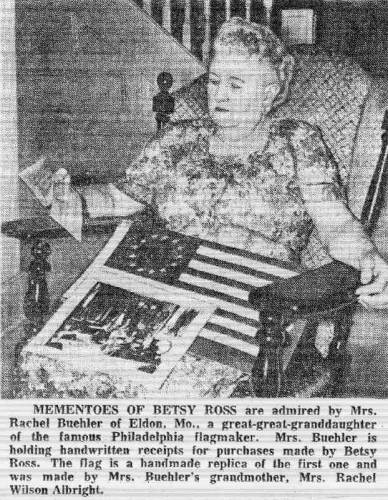
40 Mrs. Carl Buehler
Click image for larger view
Mrs. Buehler's great great grandmother was Mrs.
Elizabeth Griscom Ross Ashburn Claypoole. She is best remembered, of course, as Betsy
Ross.
Almost every American is familiar with the story of
how the pretty Betsy deftly snipped from red, white and blue cloth the proud new emblem
off the still embattled 13 colnies while General George Washington and others watched in
admiration.
Heard Story Often
"My grandmother told me about it many times when
I visited in her home in Fort Madison, Iowa," Mrs. Buehler, a handsome, white haired
lady of 71, says proudly. Her grandmother was Mrs. Rachel Wilson Albright, who was born in
Betsy's home in Philadelphia in 1812 (photo
41).
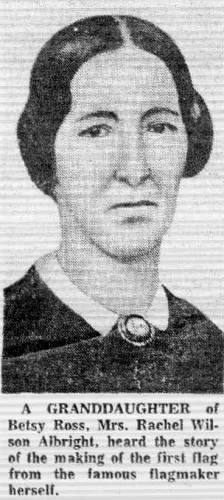
41 Granddaughter of Betsy Ross
Click image for larger view
"From the time when I was about 8 years
old until I was 15 or 16 I would go each summer to Fort Madison to visit my
grandmother," Mrs. Buehler recalls. "My father would put me on a train in St.
Louis, where we lived, and entrust me to the care of the conductor.
"As we shined the silver or did other housework,
she would tell me about Betsy making the first flag. She was very proud and retold the
story many times, recounting how she had been told of the historic event first hand by her
grandmother Betsy when she was a child.
"Grandmother Albright told of Betsy's meeting
with General Washington, Colonel George Ross (an uncle by marriage) and Robert Morris in
Betsy's home to discuss the making of a flag.
"Washington and the others had been commissioned
by the Congress to obtain a suitable flag and they had a sketch which they showed my great
great grandmother. It had stripes which some say may have come from Washington's coat of
arms and which others believe came from the flag of the East India Company. It also had 6
point stars but Betsy convinced the group that they should be 5 point stars and quickly
clipped such a star from paper to show her distinguished visitors."
Betsy Ross was a 24 year old widow at the time of the
flag making incident. Her first husband, John Ross, had been killed in the war between the
colonists and the British. She had defied her strict Quaker parents and married the
Philadelphia upholsterer and had continued his work after his death.
Another of Betsy's suggestions, Mrs. Buehler said she
was told, was that the 13 stripes be retained as they were to represent the 13 original
colonies and that stars be added in the future to indicate new states. Her idea was
accepted at the time but later was abandoned temporarily before being restored and
retained until the present.
Certain of Veracity
"There would have been no reason for my great
great grandmother to misrepresent the facts about making the flag," Mrs. Buehler
declares, "because at that time she was young enough to had had a full recollection
of Betsy's conversation."
Mrs. Buehler's relationship to Betsy Ross is through
her father's family. Her father was Daniel Albright, a son of Mrs. Rachel Wilson Albright,
who was a daughter of Mrs. Clarissa Claypoole Wilson. Mrs. Wilson. Mrs. Wilson was one of
five daughters born of Betsy's third marriage. The famous flag maker also had two children
by her second husband (but none by John Ross).
Nearly 40 years ago, a University of Arkansas
professor said his research indicated that Francis Hopkinson, a member of the second
Continental Congress, had designed the first flag. But the story of Betsy Ross as the
maker of the first flag, and instrumental to some extent in its design, has prevailed.
Mrs. Buehler is not interested in the nearly
forgotten challenge of Betsy Ross. Her interests lie in helping her husband, Carl T.
Buehler, in the operation of their drug store here, and with their son, Dr. Carl T.
Buehler, Jr. of Eldon and two grandchildren.
"No," Mrs. Buehler answers with a smile,
"I have never made a flag myself, and no one has ever asked me to. But perhaps I do
take just a little more pride in our flag than the average person because of my great
great grandmother. I hope it always will remain a symbol of freedom."
Why is Mrs. Buehler so certain the story of Betsy
Ross is true?
"Because my grandmother told me so." She
says.
Thanks to Mildred Messersmith Gray (photo 42),
I have obtained some information about two gentlemen I remember always seeing around
Hauenstein's General Store in Tuscumbia when I was a young boy.
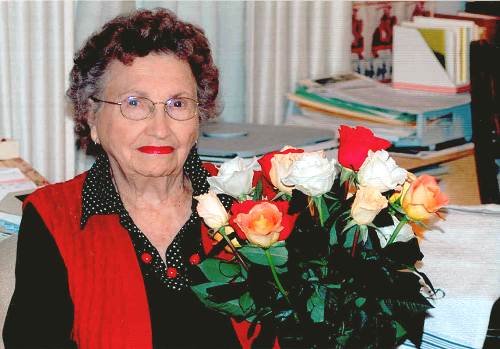
42 Mildred Messersmith Gray - Age 90 - 2007
They were the Williams brothers familiarly known as Catfish (Charles) and Friday
(Willard). They didn't have regular jobs but helped out some around the store when needed.
Catfish was the driver for Dr. Kouns since he never learned how to drive a car.
Apparently, Dr. Koons had a fear of cars because it was said he would keep the door open
with one foot sticking out in case he had to make a fast escape. How Catfish got his name
is uncertain but the story was that he was fishing one day and got a fish hook caught in
his lip. Catfish did serve in WWI; here is a photo of him in uniform sent me by his granddaughter, Nina Strange (photo 42a):
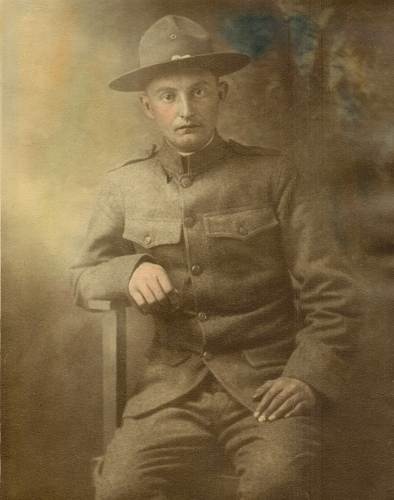
42a Charles "Catfish" Williams
Friday's name I never did learn for sure the etiology. While those readers not
from Tuscumbia may not have heard of the two brothers most Tuscumbia natives have and they
may be interested in reading Mildred's note to me:
"I remember the Williams family very well. I
know the men were the object of such amusement. I will tell you what I know. In 1900 the
family lived in Equality Township. My record does not say Tuscumbia so it may have been
after 1900 that Nancy and her brothers lived in the little house near the cemetery. The
family in 1900 was too big for that little house. I will enclose the census so you can see
for yourself as well as the cemetery listing (photo 43, photo 44
and photo 45). It looks like they came from Indiana.
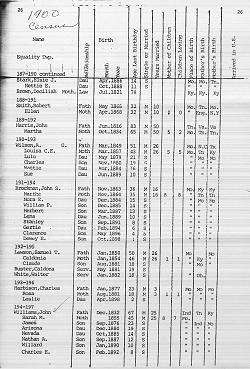
43 1900 Census 1
Click image for larger view
|
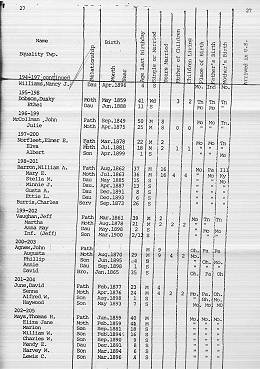
44 1900 Census 2
Click image for larger view
|
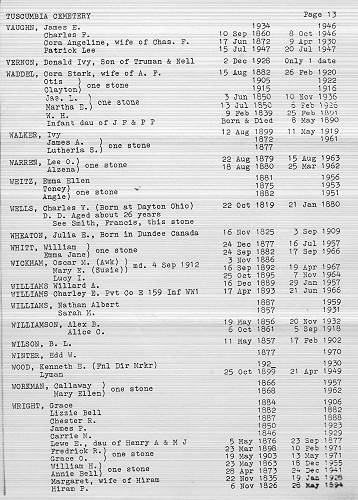
45 Tuscumbia Cemetery Names for Williams
Click image for larger view
Nancy had a son she named Riley. Everyone liked
him and had the most respect for him. He was a good fellow. I think he was about the age
of Robert (Stillwell) and Roger (Stillwell) and my brother (John Messersmith). They were
all friends and Mr. Wright (T.C. Wright, the Tuscumbia School Superintendent) took special
interest in Riley and encouraged him to be somebody. I think he may have become a county
agent as some of T.C.'s other students did.
The men's names are a little bit confusing. I think
they were really Willard and Charles. They had a third brother named Ab. Catfish is the
one who was known as "Lantern Jaw." He hung out at Mrs. Hauenstein's store and
my boy friend, later my husband, Bill Gray, nicknamed him Dewey's (Kallenbach) detective.
My brother and the Stillwell brothers liked to say, "You can't laugh like Catfish
Williams."
Catfish was Dr. Kouns' chauffeur. He had to be on
call and they said that when they drove Dr. Kouns kept the door slightly open and his
right foot in the doorway. Do you remember there were two or three houses hanging on the
side of the bluff? Mr. Stillwell (W.S. Stillwell, well known attorney) built an office
there but never used it much. I think it was Cat Williams who had a house just above that
one. He actually married and had a little girl named Betty Lou, I think. She grew up and
somehow was kidnapped into prostitution. Mr. Stillwell and another man or two helped
rescue her. I heard that the Katz drugstore people had that as a side business…Kansas
City we are talking about here.
One evening Mildred Stillwell (daughter of W.S.
Stillwell) and some other young people were playing in the cemetery (I know that sounds
strange) and Cat Williams scared them. He had a sheet around him and he rose up and said,
"Howdy folksies!" They said that Mildred jumped that six foot fence. I wasn't
among them…which is a wonder! She and I played together a lot. She was so
funny!"
Thanks Mildred.
I also asked some other Tuscumbia residents last year if they would send me some of
their memories about the Williams brothers. Marilyn (Barron) Bosso wrote me the following:
"They were two bachelors who lived up on the
hill and who did odd jobs for Ida Hauenstein. She gave them two outfits of clothes every
year. They fished on the river most of the time they weren't helping at the store."
Judson Berry, who sadly passed away earlier this year, also wrote me a line or two of
his memories of the Williams brothers:
"Friday's hat was always greasy. Catfish wore a
fedora. Friday usually sat on a nail keg on the front porch or else around on the north
side porch on the well casing. They had a sister named Nancy who later married Arthur
Edwards (he was famous for taking more ties to St. Louis by river than anyone else). They
had a brother named Ab. Friday never talked much. He had a blind eye on the left which
deviated down and always looked inflamed and red. He was very good at rolling cigarettes.
Catfish didn't work Saturdays at which time he put on
his clean khakis and took the "mail hack" to Eldon for the purpose as he put it
to "get drunk" which was followed quickly by the statement "boy do I hate
it". Catfish was the driver for Dr. Koons and after Dr. Koons, Dr. Humphrey. Dr.
Koons never learned to drive a car so he had Catfish drive him. Dr. Humphrey probably used
him since at first he was new to the area and perhaps didn't know where everyone lived. I
hope the good doctors had a substitute for Saturdays."
Thanks to all who wrote me the preceding information. What I remember the most about
Catfish was that his laugh made almost a hysterical cackling sound and it could be evoked
by what I would have considered rather "noneventful occurrences." The hat to
which Judson referred as a Fedora was still being sold in those days at Hauenstein's
store, left over from years before when they were more commonly worn. This was the type of
hat that golfers used to wear, short brimmed and made of wool or felt (photo 46). Some of these hats were even present boxed up and
stored on the second floor balcony area of the store when I was a boy. I bought several of
them for twenty five cents each and sold them at school for a dollar.
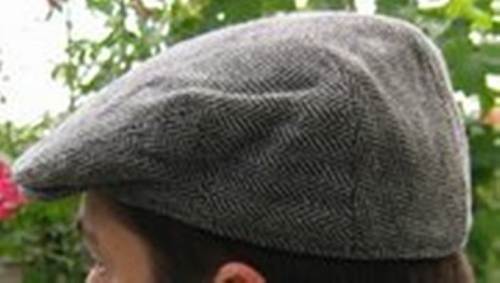
46 Catfishs Hat Style
The reason I am writing about the brothers now is because it seems odd to me that
these two men, both of them eccentrics in their own way, were so much a part of the
downtown scenery in Tuscumbia but no one paid them much attention. But their eccentricity
captured a small place in the memory of my boyhood days growing up in Tuscumbia which in
these later years raises questions about them that no one seemed to ask or care about back
then. Everyone remembers them being there but hardly anyone (except as far as I can
determine Mildred Messersmith) knew where they came from or even much of what happened to
them. So I am hoping, just for the sake of my own curiosity, that someone will read this
narrative and add some more information about this particular Williams family and
especially Cat and Friday Williams.
Next Sunday July 13 is the scheduled date for our quarterly pot luck dinner. All members as well as guests are invited for this meeting of the general membership. No charge is made, just bring one of your favorite dishes for the table is enough. We will have a short business meeting of the members after the meal at which time progress made thus far as well as plans for the future will be discussed.
That's all for this week.
| 


